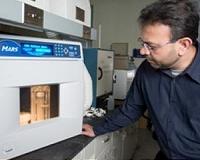 |
Berlin, Germany (SPX) Mar 22, 2011 There have been gloves and shavers for one-off use for a long time. In future, there will also be disposable endoscopes for minimally invasive operations on the human body. A new microcamera is what makes it possible. It is as large as a grain of salt, supplies razor-sharp pictures and can be manufactured very inexpensively. Endoscopy has gone through amazing advancements in recent years. Microcameras on the tip of endoscopes supply images from the inside of the human body in ever higher resolution, which often makes it possible to identify tumors at an early stage. Endoscopes to date have some downsides, since they are expensive and, because of their multiple usages, have to be put through time-consuming and exhaustive cleaning procedures every time they are used. This problem might be solved by a new microcamera that the Fraunhofer Institute for Reliability and Microintegration (IZM) in Berlin, Germany has developed together with Awaiba GmbH and with the support of the Fraunhofer Institute for Applied Optics and Precision Engineering IOF in Jena, Germany. Martin Wilke, a scientist at the Fraunhofer Institute for Reliability and Microintegration, says "we can produce microcameras so inexpensively with our technology that doctors can dispose of endoscopes after using them only once." This is made possible by a new type of manufacturing process. Digital camera systems consist of two components: a lens and a sensor that transforms the image into electrical signals. Electrical contacts on the sensor allow access to these signals and therefore also to the information of the image. Due to the way they are manufactured, these contacts are located between the sensor and the lens. The sensors are manufactured simultaneously in large numbers, like computer chips. Martin Wilke says, "you have to think of a book full of postage stamps where many thousand stamps are printed in one step. If you want to use them, you have to separate one from another. Instead of a sheet of paper, with image sensors you have a circular disc of silicon that is known as a wafer." About 28,000 image sensors fit onto one wafer and until recently, each and every one was sawed out, wired and mounted on the lens that was still missing. That means wiring them 28,000 times and mounting them just as often. The researchers at the Fraunhofer Institute for Reliability and Microintegration have streamlined this process by developing a new way to access the electrical contacts. Now, the wiring process is faster and the entire camera system is smaller. The trick lies in the fact that they do not reach the contacts of each individual image sensor via the side any more but rather, simultaneously, with all sensors via their reverse side while they are still connected as a wafer. That means that you no longer have to mount the individual lenses. Instead, you can connect them with the image sensor wafers as lens wafers. Only then is the stack of wafers sawed apart into individual microcameras. Another upside is the fact that it supplies razor-sharp pictures even with very thin endoscopes. To date, the camera systems built into them had to be divided because of their size. The lens was at the tip of the endoscope and the sensor at the other end of the glass fiber strand. The new microcamera is small enough for the tip of the endoscope. It has a resolution of 62,500 pixels and transmits the image information through the endoscope via an electrical cable. Stephan Voltz, who is the CEO of Awaiba GmbH, says that "at 1.0 times 1.0 times 1.0 millimeters, this camera is as small as coarsely ground grain of salt - the smallest camera that we are aware of." It is not only medical technology, but also the automotive industry that is interested in this tiny camera. Presently, they are researching the possibility of replacing outside rearview mirrors on cars with microcameras. This would reduce flow resistance and energy consumption. Beyond this, installed in fittings, this camera would be able to calculate the driver's eye movements and prevent him from nodding off for a few seconds. Stephan Voltz is happy about the wide range of possible applications: "Starting in 2012, using Fraunhofer's expertise, we will be able to bring disposable endoscopes to market for only a few euros - we already have the prototype."
Share This Article With Planet Earth
Related Links Fraunhofer Institute for Reliability and Microintegration (IZM) Nano Technology News From SpaceMart.com Computer Chip Architecture, Technology and Manufacture
 NJIT Prof Offers New Desalination Process Using Carbon Nanotubes
NJIT Prof Offers New Desalination Process Using Carbon NanotubesNewark NJ (SPX) Mar 16, 2011 A faster, better and cheaper desalination process enhanced by carbon nanotubes has been developed by NJIT Professor Somenath Mitra. The process creates a unique new architecture for the membrane distillation process by immobilizing carbon nanotubes in the membrane pores. Conventional approaches to desalination are thermal distillation and reverse osmosis. "Unfortunately the current membran ... read more |
|
| The content herein, unless otherwise known to be public domain, are Copyright 1995-2010 - SpaceDaily. AFP and UPI Wire Stories are copyright Agence France-Presse and United Press International. ESA Portal Reports are copyright European Space Agency. All NASA sourced material is public domain. Additional copyrights may apply in whole or part to other bona fide parties. Advertising does not imply endorsement,agreement or approval of any opinions, statements or information provided by SpaceDaily on any Web page published or hosted by SpaceDaily. Privacy Statement |